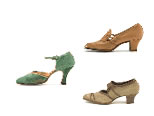Shoes history period between 1921—1930
 The 1920s were one of the most tumultuous periods of this century. With the Great War behind them, people found themselves swept away on a tide of change. Some reveled in it, some hated it, but the 20th century had truly begun. Women, celebrating such liberties as the right to vote in 1920, were now more daring than ever before. It was considered fun to smoke, visit speakeasies, wear makeup, swear, and otherwise shock conventional thinkers. Ever-shorter skirts (which reached their apex in 1927) were the rage, and young women strove to show off their knees with increasing abandon. Many girls (to the profound distress of their Victorian relatives) rolled down their stockings and painted rouge on their knees in an effort to emulate a "naughty schoolgirl" look.
The 1920s were one of the most tumultuous periods of this century. With the Great War behind them, people found themselves swept away on a tide of change. Some reveled in it, some hated it, but the 20th century had truly begun. Women, celebrating such liberties as the right to vote in 1920, were now more daring than ever before. It was considered fun to smoke, visit speakeasies, wear makeup, swear, and otherwise shock conventional thinkers. Ever-shorter skirts (which reached their apex in 1927) were the rage, and young women strove to show off their knees with increasing abandon. Many girls (to the profound distress of their Victorian relatives) rolled down their stockings and painted rouge on their knees in an effort to emulate a "naughty schoolgirl" look.Mass production and the development of affordable synthetic fabrics granted everyone access to beautiful clothing and shoes. The foot became a focal point of fashion. Shoe styles were influenced by crazes like the Charleston, a dance that demanded a securely fastened shoe with a low heel and closed toe. A single-bar pump with a pointed toe,
 high-waisted heel, and one tiny covered button was the most common style. High-tongued, cutaway-decorated, crossover, and t-straps were other popular elements.
high-waisted heel, and one tiny covered button was the most common style. High-tongued, cutaway-decorated, crossover, and t-straps were other popular elements. The late 1920s saw the adoption of two-toned spectators for men, perfect with knickers. For women, the Art Deco aesthetic ushered in muted colors and geometric styling. The elegant styles of Coco Chanel and Madeleine Vionnet are also rooted in this era, though their influences would not be truly felt until later.


0 Comments:
Post a Comment
<< Home